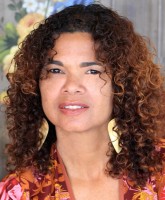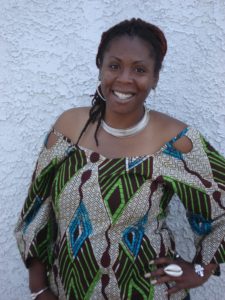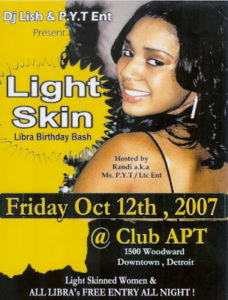Erin Aubry Kaplan could pass for white:
Married to a Jew, she might feel a need to increase her black cred, so she writes articles like this:
In the era of Black Lives Matter, the stakes are high. Not to sound apocalyptic, but the time for debate and dialogue is surely over. In 2016, the problem is clear. The question is whether America will finally undo what divides black reality from everyone else’s. This time, what’s necessary is not only a change in law or language or police chiefs. We need life change, to undo a truth that’s been commonplace for so long we barely notice it, to dislodge what has been ingrained in us all — that black lives don’t matter.
The urgency for black people comes, in part, from increased expectations. We’ve had a black president, after all. That hardly means black people believe in post-racialism, or in President Obama’s own initial lofty expectations of change. Rather, Obama’s limitations over the last eight years have reawakened us to the fact that securing racial justice can never be left to black elected officials alone, even a president. Especially a president. So black folks’ expectations are probably right where they ought to be, and we’re not backing down from them. We shouldn’t. It’s time.
Black Lives Matter fundamentally seeks equity in the criminal justice system, an end to police brutality. And then the hashtag goes deeper. A manifesto released last week by a BLM coalition spells it out: inclusion and equal regard for black people in every aspect of life, at school, at work, in politics. In a word, reparations. It’s a big ask — to bring about justice well beyond the legal sense — but one commensurate with the times: Undoing racism is on a par with solving climate change.
Perhaps blacks should start thinking that black lives matter and stop killing each other.
It’s a great gig using your white brain to make a living as a professional black. Most of America’s most successful blacks, including all the heads of the NAACP I can remember, are light-skinned, including Barack Obama.
Generally speaking, the darker the black skin, the lower the IQ. Sub-Saharan blacks in Africa, for instance, have an average IQ around 70. Aborigines in Australia have an average IQ of 55.
A Harvard professor writes in 2007:
Dark-skinned Blacks in the United States have lower socioeconomic status, more punitive relationships with the criminal justice system, diminished prestige, and less likelihood of holding elective office compared with their lighter counterparts. This phenomenon of “colorism” both occurs within the African American community and is expressed by outsiders, and most Blacks are aware of it. Nevertheless, Blacks’ perceptions of discrimination, belief that their fates are linked, or attachment to their race almost never vary by skin color. We identify this disparity between treatment and political attitudes as “the skin color paradox,” and use it as a window into the politics of race in the United States over the past half-century.
Using national surveys, we explain the skin color paradox as follows: Blacks’ commitment to racial identity overrides the potential for skin color discrimination to have political significance. That is, because most Blacks see the fight against racial hierarchy as requiring their primary allegiance, they do not see or do not choose to express concern about the internal hierarchy of skin tone. Thus dark-skinned Blacks’ widespread experience of harm has no political outlet— which generates the skin color paradox.
A dark-skinned black woman, Jasmyne Cannick, writes for NPR:
The “Light Skin Libra Birthday Bash,” which was to take place at Detroit’s Club APT, was the brainchild of a self described “dark-skinned” African-American Detroit DJ and party promoter. The party was intended to let “light-skinned” black women into a downtown club for free. In his defense, Ulysses “DJ Lish” Barnes, said that he had plans for “Sexy Chocolate” and “Sexy Caramel” parties too. The good news is that the parties have been canceled after much criticism and calls for boycotts and lawsuits.
There are no words for some of the ignorant (insert four letter word that starts with an s, rhymes with hit), that we do to ourselves. But let me give it a try.
The short version.
History has shown that black people with lighter skin were treated better. In the days of slavery, the dark-skinned blacks worked in the fields while light-skinned blacks worked in the house, hence the terms “field Negroes” and “house Negroes.” It got so bad, that not only did the slave owners, who were often responsible for the lighter shade of brown his slaves had, give lighter-skinned blacks more respect, but so did the dark-skinned blacks.
This evolved into generations of blacks both consciously and subconsciously teaching themselves that one is better than the other which eventually led to a billion dollar fake hair industry.
This was best illustrated in Spike Lee’s 1988 film “School Daze” in the scene played out in a beauty parlor between the “jiggaboos,” otherwise known as the darker-skinned blacks with nappy hair, and the “wannabe’s,” the lighter-skinned blacks with straight often times weaved hair.
But who could forget the film version of Alice Walker’s novel “The Color Purple,” in which Mister asked for Nettie who was “chocolate” colored with long hair but was given Celie, who was dark-skinned with nappy and short coarse hair instead. This was followed by a grown up Celie dealing with the harsh realities of beauty and Mista’s in-house mistress, Shug Avery.
Then you had black sororities and fraternities who used the “brown paper bag test” to deny entrance to anyone darker than the bag.
There continues to be black children who prefer to play with dolls that are white with blond hair and blue eyes. Some black children actually identify with these dolls over dolls of their own race, which could explain the 2003 case between two Georgia Applebee’s restaurant employees.
At the time, Dwight Burch, a dark-skinned waiter, was an Applebee’s restaurant employee. He filed a lawsuit against Applebee’s and his light-skinned African-American manager alleging that during his employment, the manager repeatedly referred to him as a “black monkey” and a “tar baby” and told Burch to bleach his skin. Burch claimed he was fired after he refused to do so. His case settled for $40,000.
But what about decades of rap music videos where the preferred “ho” is a lighter shade of brown? And the fact that only recently we’re seeing advertisements that highlight black women who chose to wear their hair in its natural state and are dark-skinned, even in our own magazines.
Remember actress Jennifer Beals’ famous, “I thought I would never get in. I thought they only took geniuses. But I was lucky, because I’m a minority. I’m not Black, and I’m not White, so I could mark ‘other’ on my application, and I guess it’s hard for them to fill that quota,” quote on how she got into Yale University.
Beals, whose father was black, seldom identifies with the black community despite being nominated for an NAACP Image Award. And then there was singer Prince, who despite having black parents, listed in his press bio at one time that he was Italian, among other things, when he made it in the business.
More recently there was the University of Georgia’s 2006 controversial study on skin tone which confirmed that light-skinned blacks are often more likely to be considered for jobs over dark-skinned blacks.



